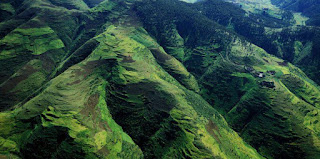I love gelato. I especially love gelato in Rome. After dinner, with good friends, lots of laughter, and all the city sounds around, it's one of the best things matter has to serve up. Of course, there are a great many other things matter has to offer, like the smell of fresh coffee early in the morning, strenuous hikes to breathtaking mountain views, astonishing music, afternoons on the beach soaking up the warmth of the sun, or a relaxing massage. The physical world is also where we experience a great deal of pain and dis-ease, but it is usually the realm we focus on. The bottom line is that, in general, I think of my sensorial experiences as simply being what they appear to be. I think of mocha gelato as being what it is, by itself.
But the Yoga Sutras say not. And so do other wisdom teachings.
If you diagrammed it, the continuum would look something like this:
Pure Consciousness
(Spirit)
Psychic Force
(Energies of attention, will, love, prayer: realm perceivable to an awakened heart)
Energy
Matter
(the physical world)
(I'm curious where the yoga sanskrit words would fit on this continuum: would svarupa (essence, own true splendor) correspond with Pure Consciousness? Would prakrti (primordial matter) and its three gunas correspond with Matter?)
But what does all this mean in practical terms? Very simply, I believe the awakened heart can influence the material world. We read in the gospels that Jesus did this all the time. He healed the sick and raised the dead and walked on water and turned well water into the finest wine. Patanjali writes
You gain
The body of perfection:
A form of light itself;
In How Yoga Works Friday observes, "Throughout history there have been reports of miracles. I mean, maybe it's a woman in a boat with a few close friends on the great Ganges River. And she walks to the side of the boat, and out onto the water itself, and walks away upon it, some distance from the boat, and turns, and stands there, with her arms open wide. And you see, it is all because of the seeds in her own mind. In that sense it is no miracle at all; it is the simple result of patient, dedicated gardening of the seeds within her own mind. She has perfected the art of self-control: she is perfect in never harming a single other living creature. And the water is helping, you see: it is . . . not wet by itself: it is only the seeds in our minds that make us see it so. And her seeds . . . are different: they are perfect. And when she looks down at the water, when she steps upon it, it is as solid as marble itself" (p. 387).
So, essentially, there is not a qualitative difference between healing a bad back with yoga (an idea most of us are pretty comfortable with), and healing burned, scarred skin into healthy skin (an idea that takes us out of our comfort zone), or healing gnarled, arthritic hands into smooth weaving hands (another idea we're not comfortable with). It's simply a quantitative difference on an energetic continuum.
Stay in that one pure thought,
And never forget it;
That single most important thing:
Things are empty
Of being what they are
By themselves. (Yoga Sutra I.43A)
Friday asks the big question:
Is this green stick a pen [how a human would see it];
or is it something to eat [how a cow would see it]?
or is it something to eat [how a cow would see it]?
The answer is Yes.
Is this flesh--born only to die; or is it pure and loving light?
The answer is Yes.
The answer is Yes.
And there will come a time
When they [beings of light and pure love] invite you
To take your place with them. (Yoga Sutra III.52A)
"Are there Angels? Can we become like them, light and our love? Can we learn to make others that way too?" asks the Captain in How Yoga Works. Friday answers, "It is what each of us is meant to be, and deep inside, you know that" (pp. 170 and 287).
But until we become beings of light, we can become more fluid travelers on the energetic continuum bound by time, opening our hearts and minds and bodies to the wonders of the dance, planting our seeds thoughtfully, purposefully, and in full awareness.
Namaste
Namaste




















